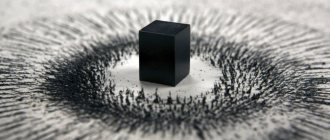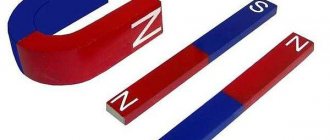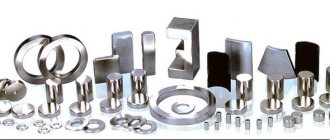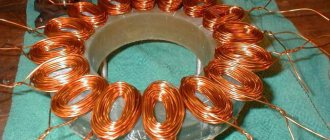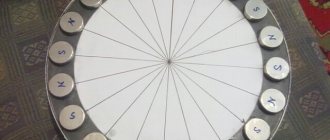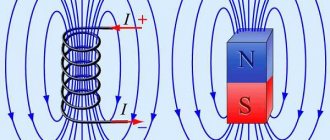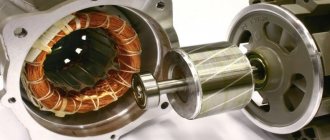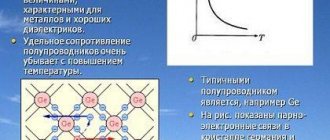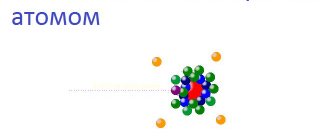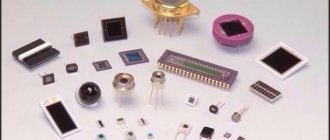4.3
Average rating: 4.3
Total ratings received: 194.
4.3
Average rating: 4.3
Total ratings received: 194.
Permanent magnets are bodies that can retain the ability to attract metal objects for a long time. What underlies this amazing property, how does a magnetic field arise, what substances can have such properties? Let's try to figure it out.
From the history of magnetism
In the VI century. BC. In ancient China, a mineral (rock) was discovered that attracted iron objects. The Chinese gave it the name “chu-shi”, which translates as “loving stone.” “Loving” - in the sense of attracting.
The word “magnet” was introduced into use by the ancient Greeks in the 5th century. BC. There is a legend that the first samples of these unusual “black stones” were found near the city of Magnesu, where deposits of magnetite were discovered. Magnet is translated as “stone from Magnesia”.
Magnetite is a black iron ore mineral, iron oxide Fe3O4, which has natural magnetic properties.
Nature and principle of action
Permanent magnets are natural substances and precision alloys with significant residual magnetization that lasts for a long time.
They are made from ferromagnetic materials - substances that can maintain magnetization in the absence of a magnetic field; they are found in a number of minerals (ores). Substances susceptible to the influence of magnets include: iron, cobalt, nickel. An alloy of iron and cobalt has higher ferromagnetic properties than each metal separately. Electrons moving in an atom due to rotation form tiny vortex magnetic fields. The basis of the magnetic field is created by an atom rotating around its own axis, like planets, their satellites, and stars.
Why are some materials not attracted to a permanent magnet, but others “stick” perfectly? It's a matter of direction, orientation of magnetic lines. In non-magnetic materials (substances with extremely weak magnetization), the fields of atoms are directed in different directions, often canceling each other rather than strengthening them.
In a number of metals, atoms are structured and combined into groups - domains - miniature magnets. At rest, a piece of steel does not have magnetic properties, and the field applied to it orders these domains; they are oriented in one direction, the lines of force add up.
Definition and main features of a permanent magnet
A permanent magnet is a solid object that can maintain a state of magnetization for a long time. The state of magnetization means the presence of a magnetic field that affects (attracts) metal objects.
Permanent magnets can be of natural origin (magnetite) or artificial, which are made from iron, steel, nickel, cobalt and other rarer metals. Artificial magnets are obtained by magnetizing workpieces in a strong magnetic field. These magnets can come in different shapes and sizes.
Rice. 1. Permanent magnets of different shapes. Strip and arc magnets
The main feature of a permanent magnet is the presence of two magnetic poles: the south - S, and the north - N. Magnetic lines are directed outside the permanent magnet from the north pole to the south, and inside the magnet from south to north.
What are magnets made of?
Iron, neodymium, boron, cobalt, samarium, alnico and ferrites are used to produce permanent and temporary magnets.
They are crushed in several stages and together melted, baked or pressed to obtain a permanent or temporary magnetic field. Depending on the type of magnets and the required characteristics, the composition and proportions of the components change.
Why does a permanent magnet have a magnetic field?
In 1820, the Danish physicist Hans Oersted, while studying electrical phenomena, discovered that if a magnetic compass needle was placed near a metal wire, then when the electric current was turned on, the needle deviated by a noticeable angle. Although he could not explain this phenomenon, after the publication of these results, the French scientist Andre-Marie Ampère suggested that the movement of electric charges in a wire - an electric current - leads to the appearance of a magnetic field. Interaction occurs and in practice the needle is deflected.
Rice. 2. Ampere's hypothesis. Ampere's model for internal currents in magnets
Ampere used the same idea to explain the nature of the magnetic field of permanent magnets. According to his theory, the magnetic field appears due to the presence in magnets of continuously circulating circular currents, which are equivalent to small magnets. These currents add up, reinforce each other and create a common magnetic field inside and outside the magnet. A magnet as a whole is a set (sum) of these magnets.
Our planet is a huge permanent magnet. The schematic diagram of the Earth's permanent magnet, which creates its magnetic field, is similar to the nature of an ordinary, natural magnet. The Earth's core has an outer shell of molten metals (iron, nickel and a number of impurities) at a temperature of more than 4000 K0. The hot mass, consisting of a mixture of charged particles, rotates along with the Earth. As a result, continuously circulating flows and vortices arise, which are the main reason for the appearance of the Earth's magnetic field.
How magnets are made in different ways
Pressed magnets are magnets made by mixing a special type of NdFeB powder with polymer binding materials. This mass is then pressed into a mold and heated.
Magnetic products obtained in this way can be of complex shapes and usually do not require additional processing. They have lower product energy than sintered magnets, up to 10 MGse.
Isotropic NdFeB magnetoplasts can be magnetized in any direction.
By using special solenoids, it is possible to obtain multi-pole magnets or magnets with a special shape of the magnetic field.
Of course, such complex solenoids can be very expensive depending on the complexity of the design and the required performance.
Cast magnets - in this method of producing magnets, NdFeB powder is mixed with a polymer material and extruded into a mold. The resulting magnetic products have product energies of up to 5 MGse, but can be made into intricate shapes.
Sintered neomagnets - fine NdFeB powder is pressed into a mold, then sintered and processed to the desired size (ground).
The production of neodymium magnets is a complex high-tech process that requires compliance with the composition and impurity content. All operations, except for grinding to size, are carried out without oxygen in a vacuum or an atmosphere of inert gases. The direction of magnetization is determined by the texture of the magnetic field during pressing.
How and what are permanent magnets made from?
Magnetites have rather weak magnetic properties. Industrial mass production of artificial magnets of various sizes has been established. The starting materials for this are alloys based on metals: iron Fe, nickel Ni, cobalt Co, neodymium Nd, samarium Sm. Blanks from these alloys are produced by casting, pressing or sintering. They are then placed in a very strong, uniform magnetic field created by electromagnets. When exposed to a magnetic field, magnetized particles are directed in one direction. This aligns the polarity of the future magnet. As a result, the workpieces are strongly magnetized and become independent permanent magnets.
Recently, polymer permanent magnets (magnetoplasts) have gained great popularity. They are made from a mixture of magnetic powder and a polymer (plastic) elastic additive, such as rubber. The magnetic properties of magnetoplasts are low, but they are quite sufficient for the manufacture of various useful devices, for example, refrigerator magnets, plastic cards, demonstration and educational boards.
How are magnets made?
Magnets are divided into different types, which differ in characteristics, durability and operating features:
- permanent,
- electromagnets,
- temporary.
Each type of magnetic product has its own characteristics and scope of application, advantages and disadvantages.
Magnetic products are produced in a huge variety of assortments, of various shapes, sizes and strengths, and are also in demand among industrial organizations and ordinary consumers for use in everyday life.
The production of magnets is a fairly profitable area that does not require large expenses to start a business. In addition, this is a creative field that can be interesting for many entrepreneurs. You can make magnetic products yourself at home and gradually increase production volume. The main thing is that you need to think about how to sell your products.
There is a wide variety of magnetic products, namely the following products:
- souvenir products;
- children's products;
- office;
- devices for household use;
- medical and health-improving devices.
In the production of magnets, various metal alloys are crushed, melted, baked or pressed to create a magnetic field. Such actions require special equipment.
To produce different types of magnetic products, different equipment is required. For example, to produce souvenir, advertising and household magnetic products you will need a computer, photo printer, various machines, a laminator, and an engraver.
When expanding products and producing other types of magnets, additional devices and special equipment will be needed - for example, various furnaces, a press, a grinding machine, etc.
They are most popular; the main feature is the retention of a magnetic charge for a long time. They are universal and in demand in all areas of life.
The service life of a magnet is affected by the composition of the alloys from which the product is made.
Permanent magnets are made from various metal alloys:
- Samarium magnets are characterized by resistance to aggressive environments, corrosion and high temperatures, but are considered fragile.
- Alnico magnets are a lightweight and heat-resistant material that can quickly demagnetize under the influence of another magnet.
- Magnetic plastics are characterized by easy processing, plasticity and elasticity, which makes it possible to create products of complex shapes.
- Ferritor magnets are the most popular option for magnetic products due to their low cost and wide range of applications, however, as a result of exposure to high temperatures, products may lose their magnetic properties.
- Neodymium magnets are currently in great demand. Their production requires appropriate equipment and certain knowledge. In this complex high-tech process, it is necessary to maintain a certain composition and content of impurities in the alloy. Neodymium magnets are widely used in such areas as the production of computer parts and powerful generators. However, neodymium magnets are considered quite fragile products.
They have magnetic properties when they are near a source of a strong magnetic field, and lose them when the magnetic field is removed. Thus, their magnetic strength is temporary. Despite the temporary magnetism, such products are useful and are used in telephones and electric motors.
They have a magnetic field only when an electric current passes through them. That is, magnetism appears when current flows through wires. They are made from a metal billet, which can be any iron or its alloys. You can check whether a metal workpiece can become a source of an electromagnetic field using an ordinary magnet.
Electromagnets are produced by winding wire around a metal workpiece, and when the size of the workpiece and the length of the wire change, the field power, the amount of electricity consumed, and the parameters of the device change. You can make electromagnets yourself, following the rules of the instructions.
Unlike other types of magnetic products, electromagnets are capable of changing characteristics as a result of exposure to electric current.
Where are permanent magnets used?
The remarkable properties of permanent magnets are used in various fields of science, technology, production, and in everyday life. Here are just a few of them:
- Recording and storing information (magnetic tapes, computer floppy disks and disks);
- Plastic cards for various purposes (financial, bonus, access control);
- Microphones, loudspeakers, sound equipment;
- Electric motors, generators, transformers;
- Compasses;
- In measuring instruments with a deflecting pointer, for example, in ammeters;
- Plastic magnets for use in educational exhibition purposes;
- Fridge magnets;
- Making fasteners for clothes and bags:
- Furniture clamps (closing doors);
- Kids toys.
3. Areas of application of permanent magnets/p> The palm among the most powerful artificial magnets today is held by magnets that include rare earth metals: neodymium (Nd-Fe-B alloy) or samarium (Sm-Co alloy). These magnets can maintain their properties without demagnetization for 30 years.
“Made with us” and on Yandex.Zen
© urfu.ru
A group of physicists from the Ural Federal University, the Institute of Metal Physics (IPM) of the Ural Branch of the Russian Academy of Sciences and the Institute of Materials Science named after. Leibniz (Bremen, Germany) was the first in the world to synthesize permanent magnets with high coercivity using 3D printing without the use of heavy rare earth metals. The breakthrough work of Ural and German scientists opens the way to obtaining effective permanent magnets of any given geometric shape using additive technologies. The researchers published an article about the experiments and their results in the prestigious journal Acta Materialia.
“We have achieved an almost twofold increase in the coercive force of magnets. Today this is the best result in the world for additive technologies for the production of permanent magnets. The absolute value of the coercivity of our magnets is more than a third higher compared to world analogues. In this case, it is fundamentally important that the infiltration of the alloy into the grain boundaries occurs simultaneously with 3D printing of magnets. “One-stage synthesis of magnets using additive technologies has been carried out for the first time,” emphasizes Alexei Volegov, associate professor of the department of magnetism and magnetic nanomaterials, senior researcher of the department of solid state magnetism at UrFU and the laboratory of magnetism and magnetic nanostructures at the Institute of Physics and Mathematics, Ural Branch of the Russian Academy of Sciences.
Now the research of scientists is of a laboratory, experimental nature. Work, including on increasing the coercive force of microcrystalline magnets, continues. The goal is cost-effective 3D mass production of permanent magnets with high coercivity and flexible configurations without the use of heavy rare earth elements.
The basis for the manufacture of magnets (in this case by laser sintering) was powders made from a nanocrystalline alloy of neodymium, iron and boron. Its advantages are that magnets made from this alloy are capable of storing more “magnetic” energy at room temperature than any other type of magnet, and also do not contain expensive cobalt, which is used in lithium-ion batteries. In addition, the required compound, which has high magnetic characteristics, can be obtained relatively easily, and the material based on it has a fairly high coercive force, that is, it is able to maintain a magnetized state when they try to remagnetize it.
At the same time, the Curie point of the main magnetic hard phase is relatively low: at temperatures above 310 °C, the material passes from a ferromagnetic state to a paramagnetic state. In other words, it loses spontaneous magnetization, turning magnetically into a “piece of wood.” Therefore, temperatures above room temperature cause the magnetic properties of the substance to quickly degrade. This reduces the efficiency and torque of motors that use such magnets.
This problem is usually solved by replacing neodymium with heavy rare earth metals - dysprosium and terbium, and iron - with cobalt. But both approaches lead to a decrease in the magnetization of the magnet material and to increased production costs, which complicates their use. Therefore, UrFU physicists, on the one hand, used a highly coercive material based on a neodymium compound, and on the other, set the task of increasing its coercivity without resorting to heavy rare earth metals. The solution was to reduce intergranular exchange interaction.
“We used two types of neodymium-based powder alloy: nanocrystalline with a grain size of 25 nanometers and microcrystalline with a grain size of 450 nanometers. In fact, by annealing the nanocrystalline alloy at 1,000°C for half an hour, we grew crystallites with an average size of 450 nm. The exchange interaction of these grains and the state of the boundary between them determine the hysteretic magnetic properties of the alloys. On the one hand, intergranular interaction allows, in some cases, to increase the residual magnetization and reduce the content of rare earth metals; on the other hand, it reduces the coercive force. We sought to weaken intergranular interaction by changing the boundary between grains,” says Alexey Volegov.
To do this, the researchers introduced into nanocrystalline and microcrystalline neodymium alloys a eutectic alloy based on rare earth metals, neodymium and cobalt, crushed and brought to a liquid state by laser heating. These alloys are known to diffuse easily along grain boundaries. This operation leads to lower magnetization values, so the content of the introduced alloy in the mixture was minimized to 20%.
The eutectic alloy firstly bonded the magnetic particles together to form a single permanent magnet from the individual neodymium alloy particles. Secondly, by filling and expanding the boundary between grains, it reduced intergranular interaction. It was found that the resulting coercivity of nanocrystalline magnets is 1.7 times greater than that of microcrystalline magnets.
Let us add that research by UrFU scientists and their colleagues from the Institute of Materials Science named after. Leibniz was supported by grants from the Ministry of Science and Higher Education of the Russian Federation and the German Science Foundation.
Reference
Permanent magnets are products made from hard magnetic materials that can maintain a state of magnetization for a long time. They are used as autonomous sources of magnetic field to convert mechanical energy into electrical energy and vice versa. The areas of application of permanent magnets are robotics, magnetic resonance imaging, the production of wind generators, DC electric motors, mobile phones, high-quality speakers, household appliances (air conditioners, refrigerators, freezers, kitchen hoods), computer hard drives, etc. The use of permanent magnets allows reduce the dimensions of products and increase their efficiency.
The development of energy and robotics, the miniaturization of high-tech devices, electric and hybrid vehicles require an annual increase in the production of permanent magnets and at the same time an improvement in their magnetic properties. Increasing the coercivity is the most important task when modifying permanent magnets.
UrFU, one of the leading universities in Russia and a participant in the 5-100 project, celebrates its centenary in 2022. The university is located in Yekaterinburg, the capital of the 2023 World University Games. UrFU initiates the creation and performs the functions of the project office of the Ural Interregional World-Class Scientific and Educational Center (REC), which is designed to solve the problems of the national project “Science”.
